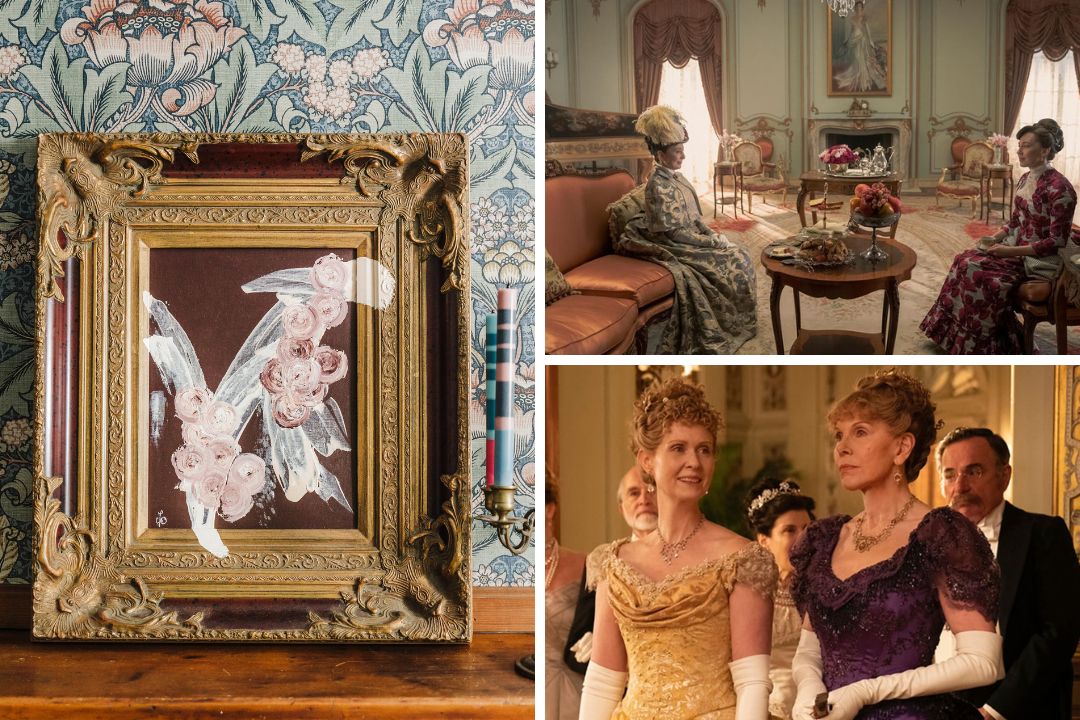
The Gilded Age Frame: Behind-the-Scenes Look at "Ropes Mansion"
Share

My jaw dropped when I found this frame tucked in a stack of artwork in an old barn at an estate sale over a year ago. When hunting for antique frames, I go in without any particular agenda other than a love for great details and wanting frames that are in good condition structurally but not museum-quality (or else I would not paint on them!).
This stunner was covered in dust and stacked amidst midcentury framed photos, a 1980s movie poster, and a few wooden signs from the "Live Laugh Love" heydays.
I carefully pulled her into the light and wiped off a layer of dust with my sleeve (someday I will remember to bring along a microfiber cloth).
Sitting in that old barn, likely for decades, was one of the most beautiful frames I had ever seen. The gilding, opulent details, deep burgandy color, and carved wood construction all immediately told me this frame was a Gilded Age showstopper begging to be made new and adored again.
Hallmarks of Gilded Age Design
Interior design during the Gilded Age mirrored the era's opulence. As the nouveaux riches sought to display their wealth, interiors became lavish showcases of affluence and taste.
Furniture
The intricately carved and ornamented Rococo Revival and Renaissance Revival styles dominated furniture design. Ornately carved wood pieces adorned the parlors, drawing rooms, and bedrooms of the wealthy elite.

Opulent bedroom in The Breakers Gilded Age Mansion located in Newport, Rhode Island
Architecture
The Gilded Age witnessed the rise of grand mansions, each a testament to architectural splendor. The Beaux-Arts style, inspired by classical Greek and Roman design, became synonymous with luxury. Mansions like the Vanderbilt's Breakers in Newport, Rhode Island, stood as architectural marvels, reflecting the grandiosity of the age.
Color Palettes
The color palette of Gilded Age interiors was a harmonious blend of rich, deep tones and luxurious metallic accents. Deep burgundies, forest greens, and navy blues created a sense of warmth and sophistication. Gold and brass accents were prevalent, adding a touch of shimmer to wallpapers, draperies, and furnishings.
Textiles
Elaborate tapestries, damasks, and brocades adorned upholstery and curtains, adding texture and a sense of indulgence. Oriental rugs, often featuring intricate patterns and deep colors, graced the floors, providing a sumptuous foundation to the lavish interiors.
Gilded Age Antique Frames
Art patronage was wildly popular during the Gilded Age. Commissioning a portrait from John Singer Sargeant, showcasing the latest Hudson River School landscape in your drawing room, or highlighting your knowledge of cutting edge styles like the emerging Impressionism said to your guests just how wealthy and cultured you were.
The popularity of art collecting at this time, especially among the "new wealthy" elite who's estates have endured as museums, means today we have a plethora of examples of not only art from this period, but the frames they were displayed in.

Opulent Details
Just like the opulent clothing, hosting, and architecture of the Gilded Age, frames from this period were full of beautiful details. Filigree, floral and fuana motifs, and scrollwork are all highlights of antique frames from this period.
Gilding
The Gilded Age, indeed! Gold accents were entirely synonymous with this era, from clothing to bookbinding to furniture and frames!

Wood Construction
Although this era was made possible by the Industrial Revolution and rapid technological advancements, frame construction wouldn't begin to be automated or utilize alternative materials until well into the 20th century.
Hand-Carved and Hand-Painted Details
Frames from the Gilded Age are artworks in an of themselves, many of which were carved and painted by hand. The use of molds and assembly line techniques to mass-produce frames wouldn't be put into use until the 1920s and 1930s.
"Ropes Mansion"

If you’re like me, your Instagram saves and Pinterest boards are full of soft, cozy vintage interiors and colorful, maximalist spaces—many of which would fit right in amongst the Gilded Age mansions (even if we live in smaller spaces). Your favorite rooms are comfortable and classic but full of personality, much like the people who curated their homes to reflect their tastes in this historic era.
This new painting marries my own contemporary, abstract art practice with the glamour of its Gilded Age frame. I approached this work knowing I wanted to pay homage to the era this frame hailed from and the Salem area I originally uncovered the frame from (hence the title). Her color palette feels both rich and fresh, blending with and highlighting the stunning details of the frame.
Ultimately, like all of my antique frame work, this piece blends contemporary abstract painting styles with its Gilded Age antique frame's charm and history. I extended the painting onto the frame, unifying the two styles.



